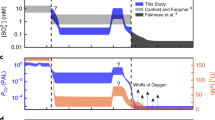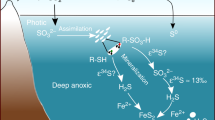Abstract
Understanding the changes in, and drivers of, isotopic variability of sulfur in seawater sulfate (δ34SSO4-sw) over geological time remains a long-standing goal, particularly because of the coupling between the biogeochemical sulfur and carbon cycles. The early Cenozoic has remained enigmatic in this regard, as the existing seawater sulfate isotopic records appear to be decoupled from the well-defined carbon isotope composition of the ocean. Here, we present a new Cenozoic record of sulfur isotopes, using carbonate-associated sulfate hosted in the calcite lattice of single-species foraminifera. The vastly improved stratigraphy afforded by this record demonstrates that carbon and sulfur cycles, as recorded by their isotopes, are not fully decoupled in the early Cenozoic. With a model driven by partial coupling of the carbon and sulfur cycles, we demonstrate that a change in sulfur isotopic fractionation of the pyrite burial flux best explains the large increase in δ34SSO4-sw ~53 million years ago (Ma) and the subsequent long steady state. We suggest that the locus of pyrite burial changed from shallow epicontinental seas and shelf environments to more open-ocean sediments around 53 Ma. Loss of extensive shelf environments corresponds to Cretaceous–Palaeogene sea-level changes and tectonic reorganization, occurring as the Himalayan arc first collided with Asia.
This is a preview of subscription content, access via your institution
Access options
Access Nature and 54 other Nature Portfolio journals
Get Nature+, our best-value online-access subscription
$29.99 / 30 days
cancel any time
Subscribe to this journal
Receive 12 print issues and online access
$259.00 per year
only $21.58 per issue
Buy this article
- Purchase on Springer Link
- Instant access to full article PDF
Prices may be subject to local taxes which are calculated during checkout


Similar content being viewed by others
References
Berner, R. A. Models for carbon and sulfur cycles and atmospheric oxygen—application to paleozoic geologic history. Am. J. Sci. 287, 177–196 (1987).
Canfield, D. E. The evolution of the Earth surface sulfur reservoir. Am. J. Sci. 304, 839–861 (2004).
Berner, R. A. GEOCARBSULF: a combined model for Phanerozoic atmospheric O2 and CO2. Geochim. Cosmochim. Acta 70, 5653–5664 (2006).
Kurtz, A. C., Kump, L. R., Arthur, M. A., Zachos, J. C. & Paytan, A. Early Cenozoic decoupling of the global carbon and sulfur cycles. Paleoceanography 18, 1090 (2003).
Paytan, A., Kastner, M., Campbell, D. & Thiemens, M. H. Sulfur isotopic composition of Cenozoic seawater sulfate. Science 282, 1459–1462 (1998).
Zachos, J. C., Dickens, G. R. & Zeebe, R. E. An early Cenozoic perspective on greenhouse warming and carbon-cycle dynamics. Nature 451, 279–283 (2008).
Paris, G., Sessions, A. L., Subhas, A. V. & Adkins, J. F. MC-ICP-MS measurement of δ34S and Δ33S in small amounts of dissolved sulfate. Chem. Geol. 345, 50–61 (2013).
Paris, G., Adkins, J. F., Sessions, A. L., Webb, S. M. & Fischer, W. W. Neoarchean carbonate-associated sulfate records positive Δ33S anomalies. Science 346, 739–741 (2014).
Paris, G., Fehrenbacher, J. S., Sessions, A. L., Spero, H. J. & Adkins, J. F. Experimental determination of carbonate-associated sulfate δ34S in planktonic foraminifera shells. Geochem. Geophys. Geosyst. 15, 1452–1461 (2014).
Wortmann, U. G. & Paytan, A. Rapid variability of seawater chemistry over the past 130 million years. Science 337, 334–336 (2012).
Schrag, D. P., Higgins, J. A., Macdonald, F. A. & Johnston, D. T. Authigenic carbonate and the history of the global carbon cycle. Science 339, 540–543 (2013).
Palike, H. et al. A Cenozoic record of the equatorial Pacific carbonate compensation depth. Nature 488, 609–614 (2012).
Halevy, I., Peters, S. E. & Fischer, W. W. Sulfate burial constraints on the Phanerozoic sulfur cycle. Science 337, 331–334 (2012).
Canfield, D. E. Sulfur isotopes in coal constrain the evolution of the Phanerozoic sulfur cycle. Proc. Natl Acad. Sci. USA 110, 8443–8446 (2013).
Leavitt, W. D. et al. Multiple sulfur isotope signatures of sulfite and thiosulfate reduction by the model dissimilatory sulfate-reducer, Desulfovibrio alaskensis str. G20. Front. Microbiol. 5, 591 (2014).
Sim, M. S., Ono, S., Donovan, K., Templer, S. P. & Bosak, T. Effect of electron donors on the fractionation of sulfur isotopes by a marine Desulfovibrio sp. Geochim. Cosmochim. Acta 75, 4244–4259 (2011).
Fike, D. A., Bradley, A. S. & Rose, C. V. Rethinking the ancient sulfur cycle. Ann. Rev. Earth Planet Sci. 43, 593–622 (2015).
Leavitt, W. D., Halevy, I., Bradley, A. S. & Johnston, D. T. Influence of sulfate reduction rates on the Phanerozoic sulfur isotope record. Proc. Natl Acad. Sci. USA 110, 11244–11249 (2013).
Gao, J., Fike, D. A. & Aller, R. C. Enriched pyrite δ 34S signals in modern tropical deltaic muds B31A-0352 (AGU Fall Meeting, 2013).
Aller, R. C., Madrid, V., Chistoserdov, A., Aller, J. Y. & Heilbrun, C. Unsteady diagenetic processes and sulfur biogeochemistry in tropical deltaic muds: implications for oceanic isotope cycles and the sedimentary record. Geochim. Cosmochim. Acta 74, 4671–4692 (2010).
Deusner, C. et al. Sulfur and oxygen isotope fractionation during sulfate reduction coupled to anaerobic oxidation of methane is dependent on methane concentration. Earth Planet. Sci. Lett. 399, 61–73 (2014).
Duan, W. M. & Chen, L. Pyrite genesis during early diagenesis in the Yellow Sea and the East China Sea. Sci. China, Ser. B, Chem. 23, 545–552 (1993).
Pasquier, V. et al. Pyrite sulfur isotopes reveal glacial−interglacial environmental changes. Proc. Natl Acad. Sci. USA 114, 5941–5945 (2017).
Werne, J. P., Lyons, T. W., Hollander, D. J., Formolo, M. J. & Damste, J. S. S. Reduced sulfur in euxinic sediments of the Cariaco Basin: sulfur isotope constraints on organic sulfur formation. Chem. Geol. 195, 159–179 (2003).
Raven, M. R., Adkins, J. F., Werne, J. P., Lyons, T. W. & Sessions, A. L. Sulfur isotopic composition of individual organic compounds from Cariaco Basin sediments. Org. Geochem 80, 53–59 (2015).
Werne, J. P. et al. Investigating pathways of diagenetic organic matter sulfurization using compound-specific sulfur isotope analysis. Geochim. Cosmochim. Acta 72, 3489–3502 (2008).
Horita, J., Zimmermann, H. & Holland, H. D. Chemical evolution of seawater during the Phanerozoic: implications from the record of marine evaporites. Geochim. Cosmochim. Acta 66, 3733–3756 (2002).
Renaudie, J. Quantifying the Cenozoic marine diatom deposition history: links to the C and Si cycles. Biogeosci. 13, 6003–6014 (2016).
Sexton, P. F. et al. Eocene global warming events driven by ventilation of oceanic dissolved organic carbon. Nature 471, 349–352 (2011).
Reyment, R. Biogeography of the Saharan Cretaceous and Paleocene epicontinental transgressions. Cretaceous Res. 1, 299–327 (1980).
Akhmetiev, M. A. & Beniamovski, V. N. Paleocene and Eocene of Western Eurasia (Russian sector)- stratigraphy, palaeogeography, climate. Neues Jahrb. Geol. P.-A. 234, 137–181 (2004).
Golonka, J. Plate tectonic evolution of the southern margin of Eurasia in the Mesozoic and Cenozoic. Tectonophysics 381, 235–273 (2004).
Schmitz, B., Pujalte, V. & Núñez-Betelu, K. Climate and sea-level perturbations during the Incipient Eocene Thermal Maximum: evidence from siliciclastic units in the Basque Basin (Ermua, Zumaia and Trabakua Pass), northern Spain. Palaeogeogr., Palaeoclimatol., Palaeoecol. 165, 299–320 (2001).
Gavrilov, Yu. O., Kodina, L. A., Lubochenko, I. Yu. & Muzylev, N. G. The late Paleocene anoxic event in epicontinental seas of Peri-Tethys and formation of the sapropelite unit: sedimentology and geochemistry. Lithol. Min. Resour. 32, 492–517 (1997).
Speijer, R. P. & Wagner, T. in Catastrophic Events and Mass Extinctions: Impacts and Beyond (eds Koeberl, C. & MacLeod K. G.) 533–549 (Geological Society of America Special Paper, Boulder, 2002).
Miller, K. G. et al. Cenozoic global sea level, sequences, and the New Jersey transect: results from coastal plain and continental slope drilling. Rev. Geophys. 36, 569–601 (1998).
Haq, B. U. & Al-Qahtani, A. M. Phanerozoic cycles of sea-level change on the Arabian Platform. Geoarabia 10, 127–160 (2005).
Miller, K. G., Fairbanks, R. G. & Mountain, G. S. Tertiary oxygen isotope synthesis, sea level history, and continental margin erosion. Paleoceanography 2, 1–19 (1987).
Higgins, J. A. & Schrag, D. P. Beyond methane: towards a theory for the Paleocene-Eocene Thermal Maximum. Earth Planet. Sci. Lett. 245, 523–537 (2006).
Bouilhol, P., Jagoutz, O., Hanchar, J. M. & Dudas, F. O. Dating the India–Eurasia collision through arc magmatic records. Earth Planet. Sci. Lett. 366, 163–175 (2013).
Tamisiea, M. E. & Mitrovica, J. X. The moving boundaries of sea level change: understanding the origins of geographic variability. Oceanography 24, 24–39 (2011).
Raiswell, R. & Canfield, D. E. Sources of iron for pyrite formation in marine sediments. Am. J. Sci. 298, 219–245 (1998).
Raiswell, R. & Berner, R. A. Pyrite and organic matter in Phanerozoic normal marine shales. Geochim. Cosmochim. Acta 50, 1967–1976 (1986).
Komar, N., Zeebe, R. & Dickens, G. Understanding long-term carbon cycle trends: the late Paleocene through the early Eocene. Paleoceanography 28, 650–662 (2013).
Claypool, G. E. in Geochemical Investigations in Earth and Space Science: A Tribute to Isaac R. Kaplan Spec. Pub. 9 (eds Hill, R. J. et al.) 59–65 (Geochemical Society, Amsterdam, 2004).
Jagoutz, O., Royden, L., Holt, A. F. & Becker, T. W. Anomalously fast convergence of India and Eurasia caused by double subduction. Nat. Geosci. 8, 475–478 (2015).
Katz, M. E. et al. Biological overprint of the geological carbon cycle. Mar. Geol. 217, 323–338 (2005).
McCorkle, D. C., Corliss, B. H. & Farnham, C. A. Vertical distributions and stable isotopic compositions of live (stained) benthic foraminifera from the North Carolina and California continental margins. Deep-Sea Res. Pt I 44, 983–1024 (1997).
Cande, S. C. & Stegman, D. R. Indian and African plate motions driven by the push force of the Reunion plume head. Nature 475, 47–52 (2011).
Miller, K. G. et al. The Phanerozoic record of global sea-level change. Science 310, 1293–1298 (2005).
Acknowledgements
We thank M. Vautravers for her expertise with Palaeogene foraminifera and S. Misra, G. Antler and W. Fisher for helpful discussions and advice. This work was supported by a ‘Small Sulfur’ NERC grant (NERC NE/H011595/1), the ERC (ERC StG 307582, CARBONSINK to A.V.T.) and a NERC studentship to V.C.F.R.
Author information
Authors and Affiliations
Contributions
V.C.F.R. designed the cleaning tests, did the lab work and analysis for trace element analysis and sulfur isotopes, and wrote the model and the paper. G.P. advised on the cleaning tests, did sulfate and sulfur isotope preparation and analysis, was heavily involved in the modelling and wrote the paper. A.L.S. provided equipment and fruitful discussions. S.A. picked the foraminifera for the stable isotope analyses. A.V.T. provided extensive advice and funding at all stages, had the idea for the shift in 34εSO4-pyr and wrote the paper. J.F.A. provided guidance and lab equipment for lab work and analysis, advised extensively on the model and wrote the paper.
Corresponding author
Ethics declarations
Competing interests
The authors declare no competing interests.
Additional information
Publisher’s note: Springer Nature remains neutral with regard to jurisdictional claims in published maps and institutional affiliations.
Supplementary information
Supplementary Information
Supplementary text.
Foram δ34S data
Foram δ34S data.
δ13C input data
δ13C input data.
Definitions uncoupled
MATLAB code.
Equations uncoupled
MATLAB code.
Solve uncoupled
MATLAB code.
Rights and permissions
About this article
Cite this article
Rennie, V.C.F., Paris, G., Sessions, A.L. et al. Cenozoic record of δ34S in foraminiferal calcite implies an early Eocene shift to deep-ocean sulfide burial. Nature Geosci 11, 761–765 (2018). https://doi.org/10.1038/s41561-018-0200-y
Received:
Accepted:
Published:
Issue Date:
DOI: https://doi.org/10.1038/s41561-018-0200-y
This article is cited by
-
An 80-million-year sulphur isotope record of pyrite burial over the Permian–Triassic
Scientific Reports (2022)
-
Proxy evidence for state-dependence of climate sensitivity in the Eocene greenhouse
Nature Communications (2020)
-
The benthic foraminiferal δ34S records flux and timing of paleo methane emissions
Scientific Reports (2020)
-
The Isotopic Imprint of Life on an Evolving Planet
Space Science Reviews (2020)



